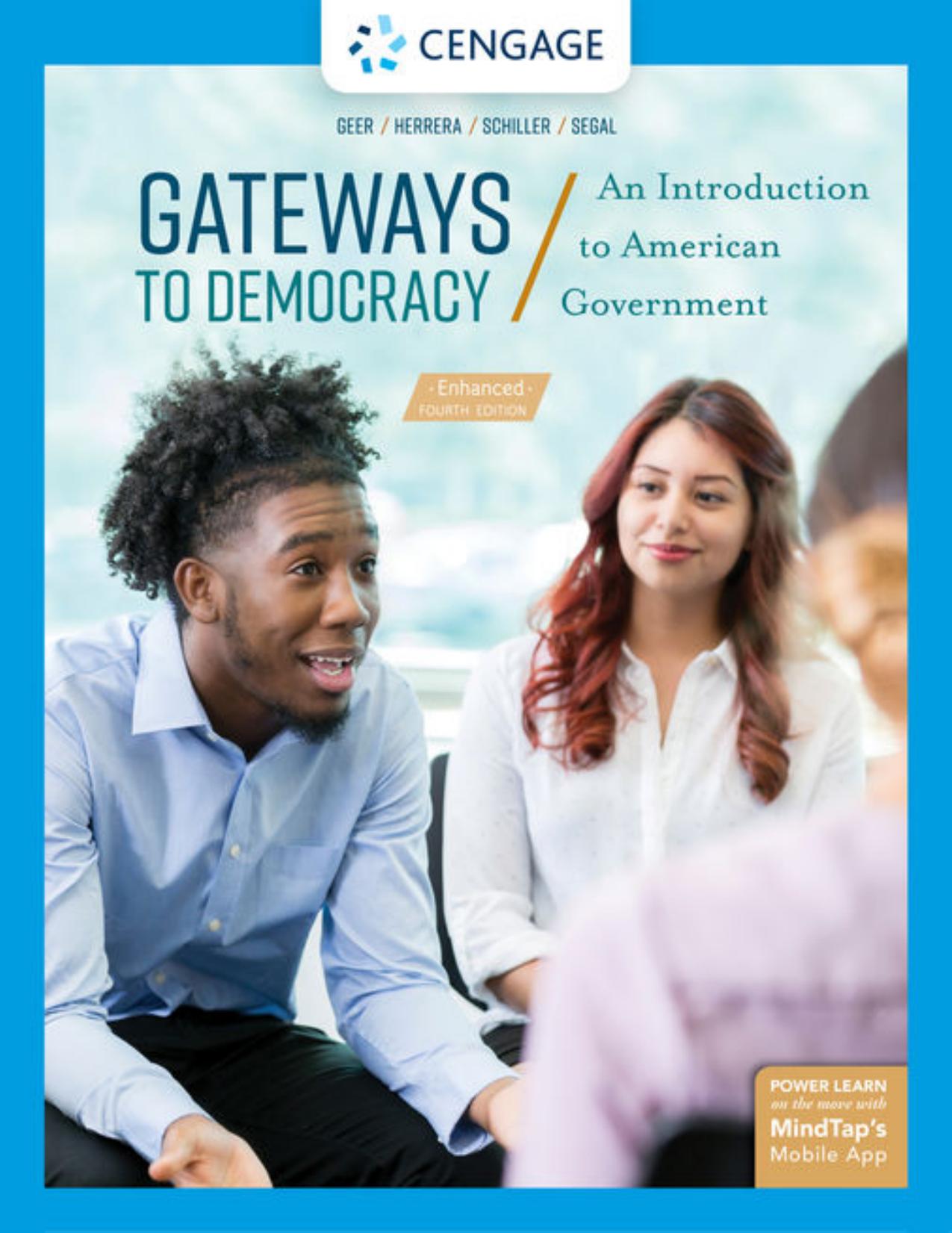Gateways to Democracy An Introduction to American Government 4th Edition by John Geer 1337799807 9781337799805
$70.00 Original price was: $70.00.$35.00Current price is: $35.00.
Instant download Gateways to Democracy An Introduction to American Government E. Geer & Richard Herrera & Wendy J. Schiller & Jeffrey A. Segal after payment
Gateways to Democracy An Introduction to American Government 4th Edition by John Geer – Ebook PDF Instant Download/Delivery: 1337799807, 9781337799805
Full download Gateways to Democracy An Introduction to American Government 4th Edition after payment

Product details:
ISBN 10: 1337799807
ISBN 13: 9781337799805
Author: John Geer
Geer/Herrera/Schiller/Segal’s GATEWAYS TO DEMOCRACY, ENHANCED, 4th edition, introduces the American political system to students, pointing out in each chapter the “gateways” that facilitate, or at times block, participation. In emphasizing how the political system works, and how individuals and groups have opened gates to influence public policy, the text helps students see the relevance of government in their own lives. Completely up to date, the ENHANCED edition includes updates–and impacts–from the 2018 elections as well as expanded discussion of diversity and participation that reflects America’s changing demographic infrastructure. In every chapter, Supreme Court cases illustrate the constitutional and legal context in which U.S. democracy has evolved, while a Political Analytics feature helps students evaluate the vast amounts of data present in today’s political discourse.
Gateways to Democracy An Introduction to American Government 4th Table of contents:
Chapter 1: Gateways to American Democracy
1.1 Gateways: Evaluating the American Political System
1.2 Democracy and the American Constitutional System
1.3 American Political Culture
1.4 Responsiveness and Equality: Does American Democracy Work?
1.5 The Demands of Democratic Government
Chapter 2: The Constitution
2.1 Before the Constitution
2.2 The Constitutional Convention
2.3 Government Under the Constitution
2.4 The Ratification Debates
2.5 The Responsive Constitution
Chapter 3: Federalism
3.1 Why Federalism?
3.2 Constitutional Framework
3.3 The Changing Nature of American Federalism
3.4 State and Local Governments
Chapter 4: Civil Liberties
4.1 What Are Civil Liberties?
4.2 Civil Liberties in Times of Crisis
4.3 The First Amendment and Freedom of Expression
4.4 Religious Freedom
4.5 The Right to Keep and Bear Arms
4.6 Criminal Procedure
4.7 The Right to Privacy
Chapter 5: Civil Rights
5.1 What Are Civil Rights?
5.2 Legal Restrictions on Civil Rights
5.3 The Expansion of Equal Protection
5.4 The End of Legal Restrictions on Civil Rights
5.5 Frontiers in Civil Rights
Chapter 6: Public Opinion
6.1 The Power of Public Opinion
6.2 Public Opinion Polls
6.3 What Drives Public Opinion?
6.4 The Shape of Public Opinion
6.5 Group Differences
Chapter 7: The News and Social Media
7.1 Political News
7.2 The Law and the Free Press
7.3 The History of the Press in America
7.4 Mass Media in the Twenty-First Century
7.5 The Impact of the News Media on the Public
7.6 Evaluating the News Media
Chapter 8: Interest Groups
8.1 Interest Groups and Politics
8.2 Types of Interest Groups
8.3 What Interest Groups Do
8.4 The Impact of Interest Groups on Democratic Processes
8.5 Characteristics of Successful Interest Groups
Chapter 9: Political Parties
9.1 The Role of Political Parties in American Democracy
9.2 The Dynamics of Early Party Development
9.3 The Effects of a Two-Party System
9.4 Party Alignment and Ideology
Chapter 10: Elections and Campaigns
10.1 The Constitutional Requirements for Elections
10.2 Presidential Campaigns
10.3 Issues in Presidential Campaigns
10.4 Congressional Campaigns
10.5 Issues in Congressional Campaigns
Chapter 11: Voting and Participation
11.1 The Practice and Theory of Voting
11.2 The History of Voting in America
11.3 Who Votes?
11.4 Why Citizens Vote
11.5 Assessing Turnout
11.6 Voting Laws and Regulations
11.7 Participation Beyond Voting
Chapter 12: Congress
12.1 Congress as the Legislative Branch
12.2 The Powers of Congress
12.3 The Organization of Congress
12.4 The Lawmaking Process
12.5 The Member of Congress at Work
Chapter 13: The Presidency
13.1 Presidential Qualifications
13.2 Presidential Power: Constitutional Grants and Limits
13.3 The Growth of Executive Influence
13.4 The President in Wartime
13.5 Organization of the Modern White House
13.6 Presidential Greatness
Chapter 14: The Bureaucracy
14.1 The American Bureaucracy
14.2 Core Components of the Bureaucracy
14.3 Historical Evolution of the Bureaucracy
14.4 Accountability and Responsiveness in the Bureaucracy
Chapter 15: The Judiciary
15.1 The Role and Powers of the Judiciary
15.2 State and Lower Federal Courts
15.3 The Supreme Court
15.4 Judicial Decision Making
15.5 The Appointment Process for Federal Judges and Justices
15.6 Historical Trends in Supreme Court Rulings
Chapter 16: Economic, Domestic, and Foreign Policy
16.1 Public Policy Under a Constitutional System
16.2 Domestic Policy
16.3 Economic Policy
16.4 Foreign Policy
People also search for Gateways to Democracy An Introduction to American Government 4th:
mcgraw hill american democracy now
7 principles of american democracy
6 principles of american democracy
3 theories of american democracy


